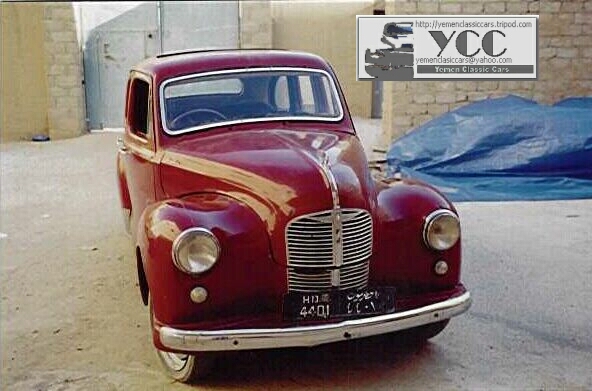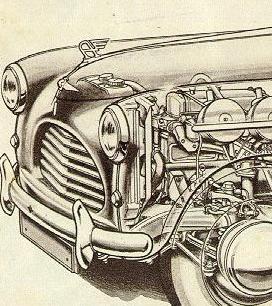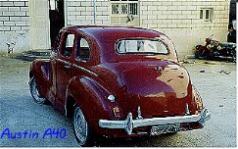|
Car
Name |
Austin |
Model |
A40 |
Year |
1949 |
 |
Description |
Personal
History |
| Serial
Number: 448691 |
| No.
of |
| Engine
Tag No |
| Units
In Stock |
| TRANSMISSION
Overall gear ratios.
1st 15.64
2nd 9.52
3rd 5.91
4th 4.33
Reverse 20.45
DIMENSIONS
Wheelbase 8'4" (aprx
2550mm)
Track 4'3.5" (aprx 1300mm)
Length 14'11.5" (aprx 4560mm)
Width 5'3.5" (aprx 1610mm)
Tires 5.90x14
Weight 21.75cwt
Fuel Tank 10galls
SUSPENSION
Independent Coils at Front
Semi Elliptic at rear |
- BRAKES
- Girling hydraulic drum
- brakes with wedge operated
- shoes
9in drums.
|
|
|
|
|
Gasoline
Engine ,4 Cylinders, 15 HP, 4 Doors, sunroof. 2 separated seats in
the front and 1 long seat in the back. Original color Red, Current
color is dark green. |

More Details Will Be Added
Soon, YCC
سنظيف
المزيد من
المعلومات
في القريب
العاعجل
فضلا زرنا
مرة اخرى
|
|
Links
|
Industry
History |
Other
Information |
|
Austin's Third Chapter in America (Imported)
With the close of the war, Leonard Lord then head of the Austin Motorcar Company, decided to spend 1,000,000 pounds on the infrastructure of the corporation so as to prepare it to resume consumer production. Also at the close of the war there was a movement in England
towards the Labour party and to nationalize many
industries, due in part to the shortage of resources brought about by the war. Many of the vital industries needed for the manufacture of automobiles such as power generation (coal and oil were in short supply) were not able to run around the clock as in the past. With
natural resources in short supply production was cut back and hence, it was difficult to absorb all the returning soldiers back into the work force. This caused a recessionary effect on the economy and the heavy tax levied on the purchase of new automobiles and the gas
rationing (as little as 7 gallons per month) did little to spur
sales in the UK. Lord recognized in 1945 that, if Austin was to survive as a company they would have to rely on foreign markets. The next step was to design a car that would appeal both the home and to the largest
forging market, the USA. Then, sometime between the summer of 1945 and spring of 1947, it is unclear to this author, the A40 was conceived, designed and developed, with the first one being built in apparent secrecy. Austin's were once again imported to the U.S. starting in the late
summer and fall of 1947. This new "modern" Austin looked very much like the late 30's and early 40's General Motors products, sporting the 6 window look (3 per side). The A40 had some very unique features including:
Full box frame
Independent wishbone front suspension
Hydraulic brakes in the front and mechanicals in the rear
1200 CC 40 horsepower OHV engine .
16 inch tires
A jacking system operated from the interior
Leather interior and
A sunroof
The acceptance and popularity of the A40 inspired Austin to begin shipping the A90 Atlantic sport car as well as a few of the larger (A125 & 135) models to the States. Unfortunately, the A90 sales were not good and the A40 was receiving a luke warm reception in the States. A final effort was made to bolster the sales in 1951 by modernizing the A40. The "new" A40 included
improvements such as: A new dash with instruments mounted in the center 4 wheel hydraulic brakes
Column shift and A MkII rear axle, adding 5mph to the top speed This final effort failed as the American public was quickly moving on to the modern looking coachwork. By 1952 the effort to import to the American market was abandoned. Sales continued through 1953 and early 1954. And to the best of my knowledge, only 54 A40's remain in running condition today in the USA.
Note: The A40 was an important development in the history of the
English automobile. The block and many of the other internal and external parts of the A40's engine can be found in the BMC's "B" series engine and other parts through the early 1970's. Austin's Final Chapter (Austin in
Disguise?) In 1951 the American Nash company had started design work on a small 2 seater called the NX1 they intended to add to their line. The design originally called for the mechanical systems to be provided
by Fiat. But soon after Nash president George Mason was introduced to Len Lord, president of Austin by Donald Healey (helped to create the Nash-Healey sports car) an agreement was reached for the Austin
Motorcar Company to produce the "Nash" Metropolitan. As a result of the agreement, Nash would hold exclusive marketing rights for the
Metro. The first Metropolitans were rolling off the assembly line in spring
of 1954. costing less than $1500, it had all the great styling that
made Nash famous. If the larger Nash models were upside-down bathtubs then the Metropolitan had to be an upsidedown soap dish. To add to the smooth lines of the body, there was no outside access to the trunk (or even a trunk lid). The rear trunk was accessed through the toneau type cover located in the area behind the bench seat. It was a 2 seater and came in the form of a hardtop or convertible and even had "room" for children directly behind the modest bench seat. It sported such standard equipment as a heater, a radio and a continental spare. Some of the options included, two tone paint and whitewall
tires. The mechanicals were mostly borrowed from the Austin A40 (see above)
and the A30 models. 1200 cc engine (A40) Steering Suspension and Brake systems The transmission was only
available in the standard (American preference) three on the tree and then finally, in 1956 the engine was upgraded to the B-series BMC 1489 cc four cylinder.
In 1957 Austin secured the right to market and sell the Metro in foreign markets where AMC did not trade. Austin never put their badge on the Metro (probably a good decision) but chose to market it simply as the Metropolitan 1500. These right hand drive models were
never really embraced by foreign markets and the British politely tolerated it as an oddity.By 1959 the big three in Detroit were turning out their own compacts and by 1960 AMC decided to abandon the Metro. The only real change to the body by this time was the addition of a trunk lid for access to the trunk from the outside of the vehicle. The leftover stock took a long time to sell in America, dragging into 1961 and a few as late as 1962.
Total production numbers for the US were 19,399 convertibles and 75,569 hardtops. Approximately 9,400 units were distributed in the UK and other markets.
Due to the uni-body construction and the sometimes harsh climates of the states, few of these cars are actually in running condition today but there are several clubs and web pages out there where you can get more information on these little cars. If you have any information to add to this, or comments about it,
please e-mail me. Also, if you would like to do a guest feature about the history of your favorite automobile, I'd be happy to hear your ideas.
|
Austin From the Ashes
In 1935, Roy Evans, a former top salesman for Austin, decided to attempt a buy out and revival of the little car. After some haggling and some legal maneuvering, Evans was awarded the company for a mere five thousand dollars. Then, armed with a $250 million loan from the
Reconstruction Finance Corporation, Evans reopened the factory in 1937 under the name of American Bantam.
Several changes were made to the engine. They changed from roller mains to
babitt, a third main bearing was also added, pressurized lubrication, new manifold,
new steering gear, new three speed transmission
and a new final drive. In addition to the changes in the mechanical systems, the pseudo Austin received a radical face lift consisting of: a rounded grill, a smooth and slightly rounded hood, fenders that were shaped similar to the Dusenberg and Auburn speedsters and a slopping rear deck on the roadsters. Despite these dramatic changes, the Bantam did not survive past 1941. Total production numbers for the Bantam (according to my
research) never exceeded 4,139. There is however, a lesser known footnote to the Bantam story. In late 1939 Bantam adapted a scout car to meet the specifications for the U.S. Army's general purpose vehicle (Jeep). (Yes . . . . Bantam invented the Jeep!, they even won a court case against Willys-Overland (who claimed to have invented the Jeep)). Bantam produced Jeeps throughout WW II, closing their doors on auto production at the end of the war. It is unclear as to who took over the lead of the company after Evans left at the close of the war, but the company apparently manufactured some sort of trailers until 1956 when the plant was sold to Armco Steel
Company.
The Austin in America
Old Motors' September Feature, by Donald Kloepfer I love all cars, but I am really interested in small cars. Perhaps my all time favorite small car is the American Austin and the later Bantam. That is why my pick for this month is the Austin. Austin's First Chapter in America
After introducing the very successful Austin 7 in England, Sir Herbert Austin came to America in 1929, looking for a licensed manufacturer to produce the car in America. Austin chose to produce his car in the city of Butler, Pennsylvania. Butler had what he was looking for:
it was close enough to the East Coast that the importation of parts from England would be easy,
they had a ready and willing workforce, and they had easy access to a variety of industrial services. By 1930, the American Austin was being manufactured in the old
Standard Steel Car Co. factory. (Incidentally, the Standard Steel Car Company was in existence from 1913 to 1923, and then reorganized as Standard Motor Car Co. in 1922) The American Austin was manufactured from 1930 through 1934. The engine was (as near as I can tell) the same design as that of the English Austin 7, a 46 cubic inch L-head 4 cylinder with only two main bearings. The engine produced between 13 and 14 horsepower at 3200 RPM. Weighing in at between 1100 and 1200 pounds, the little car was by far the lightest car in production in America, but was probably just too light for the American people's comfort. The car's wheelbase, at 75 inches, was 16 inches shorter than a VW Beetle,
making it a mini car even by today's standards. In 1930, 8,558 cars were produced with only two models available: a roadster selling for $445 and a coupe priced at $465. In the following years, a business coupe, Deluxe coupe and a 2 and 4 passenger Cabriolet were added to their offering. By 1933 sales were so poor that the business coupe price dropped to only $275 and the
roadster to $315. In my mind, the American Austin was the right car in the wrong country or maybe just at the wrong time. Despite its lack of success with the general public, it enjoyed a significant amount of success in Hollywood. Among the more notable Austin owners were: Buster
Keyton, Al Jolson and the kids from "Our Gang". The Austin was also used in numerous movies such as "International House" and Will Rogers' "A Connecticut Yankee in King Arthur's Court". Ultimately, the American Austin was not able to survive the depression and went
into receivership, finally ceasing production in 1935.
|
| |
Condition |
| |
The
car is in a very good condition. The original engine still in great
condition, the body has no dent, Lead Time and the interior is clean
with clothed seats. Running until 1982. |
| |
| |
|
Actual
Model |
|

|
|
Actual
Model |
|
|
 
|
|
|